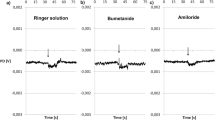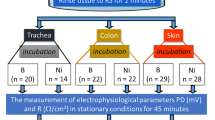Abstract
-
1.
Na+ transport across abdominal skins of the frog speciesRana esculenta andRana pipiens was analyzed by recording short-circuit current (I sc), transepithelial conductance (G t), and the current noise generated by the random blockage of apical Na+ channels by the diuretic, amiloride.
-
2.
Specific Na+ current (I Na) and conductance (G Na), as reflected by the amiloride-sensitive part ofI sc andG t, respectively, were markedly depressed after addition of some osmotically active substances, like sugars or alcohols to the mucosal Na+-Ringer solution. These hypertonicity-induced reactions were fast and fully reversible, even at mucusal osmolarities of 1 Osmol.
-
3.
With muscosal solutions of moderate hyperosmolarity a recovery ofI Na andG Na was observed in presence of the osmotic gradient. This “regulatory” current showed to be carried by Na+ through the Na+-specific apical channels. Contrary to the fast current drop during the intial phase of hyperosmotic shocks, the “osmoregulation” was considerably slower. The recovery ofI Na was only complete at smaller osmotic gradients but became more and more suppressed at higher osmolarities.
-
4.
Steady-state analysis of the kinetics of the Na+-specific current revealed that the current depression by osmotic shocks obeys Michaelis-Menten kinetics. This current depression at high osmolaritics, as well as during the initial phase before “osmoregulation” with small osmotic gradients, can be described in terms of a non-competitive inhibition. This was also suggested by Na+-concentration jump experiments indicating a reduction of the maximal, apical Na+ permeability as mechanism of the hypertonicity-induced drop inI Na. TheI Na kinetics after complete “osmoregulation” were, however, indistinguishable from the isotonic control condition.
-
5.
In the presence of the Na+-channel blocker, amiloride, the relaxation, or Lorentzian, noise component inI Na was analyzed to yield microscopic parameters like single Na+-channel current (i), channel density (M), as well as the association (k 01) and dissociation (k 10) rate constants for the blocker reaction between amiloride and its receptor at the apical Na+ channel. With mucosal hypertonicity amiloride blocks less effectively, becausek 01 is markedly reduced whereas changes ink 10 could not be demonstrated. Furthermore, hypertonicity dramatically reducesM andi. While, after “osmoregulation” with small osmotic gradients, the reduction ink 01 is still clearly observed,M andi gain their original values as if they were in isotonic condition.
Similar content being viewed by others
References
Bentley PJ, Candia OA, Parisi M, Saladino AJ (1973) Effects of hyperosmolality on transmural sodium transport in the toad bladder. Am J Physiol 225:818–824
Biber TUL, Curran PF (1970) Direct measurement of uptake of sodium at the outer surface of the frog skin. J Gen Physiol 56:83–99
Bindslev N, Tormey JM, Pietras RJ, Wright EM (1974a) Electrically and osmotically induced changes in permeability and structure of toad urinary bladder. Biochim Biophys Acta 332:286–297
Bindslev N, Tormey JM, Wright EM (1974b) The effects of electrical and osmotic gradients on lateral intercellular spaces and membrane conductance in a low resistance epithelium. J Membr Biol 19:357–380
DiBona DR, Civan MM (1973) Pathways for movement of ions and water across toad urinary bladder. I. Anatomic site of transpithelial shunt pathways. J Membr Biol 12:101–128
Erlij D, Martinez-Palomo A (1972) Opening of tight junctions in frog skin by hypertonic urea solutions. J Membr Biol 9:229–240
Finn AL, Bright J (1978) The paracellular pathway in toad urinary bladder: permselectivity and kinetics of opening. J Membr Biol 44:67–83
Fuchs W, Hviid Larsen E, Lindemann B (1977) Current-voltage curve of sodium channels and concentration dependence of sodium permeability in frog skin. J Physiol 267:137–166
Grinstein S, Erlij D (1978) Intracellular calcium and the reglation of sodium transport in the frog skin. Proc R Soc Lond Biol 202: 353–360
Helman SI, Cox TC, Van Driessche W (1983) Hormonal control of apical membrane Na transport in epithelia: Studies with fluctuation analysis. J Gen Physiol 82:201–220
Hillyard SD, Zeiske W, Van Driessche W (1982) A fluctuation analysis study of the development of amiloride-sensitive Na+ transport in the skin of larval bullfrogs (Rana catesbeiana). Biochim Biophys Aacta 692:455–461
Hoffmann EK (1977) Control of cell volume. In: Gupta BJ, Moreton RB, Ocsman JL, Wall BJ (eds) Transport of ions and water in animals. Academic Press, London, pp 285–332
Katz U (1981) The effect of salt adaptation and amiloride on thein vivo acid-base status of the euryhaline toadBufo viridis. J Exp Biol 93:93–99
Li JHY, Palmer LG, Edelman ID, Lindemann B (1982) The role of sodium channel density in the natriferic response of the toad urinary bladder to an antidiuretic hormone. J Membr Biol 64:77–89
Lief PD, Essig A (1973) Urea transport in the toad bladder; coupling of urea flows. J Membr Biol 12:159–176
Lindemann B (1980) The beginning of fluctuation analysis of epithelial ion transport. J Membr Biol 54:1–11
Lindemann B, Van Driessche W (1977) Sodium-specific membrane channels of frog skin are pores: Current fluctuations reveal high turnover. Science 195:292–294
Lindemann B, Van Driessche W (1978) Thermechanism of Na uptake through Na-selective channels in the epithelium of frog skin. In: Hoffman JF (ed) Membrane transport processes, vol 1. Raven Press, New York, pp 155–178
Lindermann B, Voûte C (1976) Structure and function of the epidermis. In: Llinas R, Precht W (eds) Frog neurobiology. Springer, Berlin Heidelberg New York, pp 169–210
Lipton P (1972) Effect of changes in osmolarity on sodium transport across isolated toad bladder. Am J Physiol 222:821–828
Macknight ADC, DiBona DR, Leaf A (1980) Sodium transport across toad urinary bladder: a model “tight” epithelium. Physiol Rev 60:615–715
Macknight ADC, Leaf A (1977) Regulation of cellular volume. Physiol Rev 57:510–573
MacRobbie EAC, Ussing HH (1961) Osmotic behaviour of the epithelial cells of frog skin. Acta Physiol Scand 53:348–365
Nagel W, Durham JH, Brodsky WA (1981) Electrical characteristics of the apical and basal-lateral membranes in the turtle bladder epithelial cell layer. Biochim Biophys Acta 646:77–87
Reuss L, Finn AL (1975) Effects of changes in the composition of the mucosal solution on the electrical properties of the toad urinary bladder epithelium. J Membr Biol 20:191–204
Urakabe S, Handler JS, Orloff J (1970) Effect of hypertonicity on permeability properties of the toad bladder. Am J Physiol 218:1179–1187
Ussing HH (1963) Effects of hypertonicity produced by urea on active transport and passive diffusion through the isolated frog skin. Acta Physiol Scand 59:155–156
Ussing HH (1965) Relationship between osmotic reactions and active sodium transport in the frog skin epithelium. Acta Physiol Scand 63:141–155
Ussing HH (1966) Anomalous transport of electrolytes and sucrose through the isolated frog skin induced by hypertonicity of the outside bathing solution. Ann NY Acad Sci 137:543–555
Ussing HH (1978) Physiology of transport regulation. J Membr Biol (Special issue): 5–14
Ussing HH (1982) Volume regulation of frog skin epithelium. Acta Physiol Scand 114:363–369
Van Driessche W (1983) Apical K+ permeability of frog skin: controlled by intracellular mediators? Arch Int Physiol Biochim 91:P55–P56
Van Driessche W, Erlij D (1983) Noise analysis of inward and outward Na+ currents across the apical border of ouabaintreated frog skin. Pflügers Arch 398:179–188
Van Driessche W, Gullentops K (1982) Conductance fluctuation analysis in epthelia. In: Baker PF (ed) Techniques in the life sciences, techniques in cellular physiology. Elsevier Biomedical, Part II, P123, pp 1–13
Van Driessche W, Lindemann B (1979) Concentration dependence of currents through single sodium-selective pores in frog skin. Nature 282:519–520
Van Driessche W, Zeiske W (1980) Ba2+-induced conductance fluctuations of spontanously fluctuating K+ channels in the apical membrane of frog skin (Rana temporaria). J Membr Biol 56:31–42
Voûte CL, Møllard K, Ussing HH (1975) Quantitative relationship between active sodium transport, expansion of endoplasmic reticulum and specialized vacuoles (“scalloped sacs”) in the outermost living cell layer of the frog skin epithelium (Rana temporaria). J Membr Biol 21:273–289
Voûte CL, Ussing HH (1968) Some morphological aspects of active sodium transport. The epithelium of the frog skin. J Cell Biol 36:625–638
Wade JB, Revel JP, DiScala VA (1973) Effect of osmotic gradients on intercellular junctions of the toad bladder. Am J Physiol 224:407–415
Zeiske W (1978) The stimulation of Na+ uptake in frog skin by uranyl ions. Biochim Biophys Acta 509:218–229
Zeiske W, Lindemann B (1974) Chemical stimulation of Na+ current through the outer surfac of frog skin epithelium. Biochim Biophys Acta 352:323–326
Zeiske W, Van Driessche W (1979) Saturable K+ pathway across the outer border of frog skin (Rana temporaria): Kinetics and inhibition by Cs+ and other cations. J Membr Biol 47:77–96
Zeiske W, Wills NK, Van Driessche W (1982) Na+ channels and amiloride-induced noise in the mammalian colon epithelium. Biochim Biphys Acta 688:201–210
Author information
Authors and Affiliations
Rights and permissions
About this article
Cite this article
Zeiske, W., Van Driessche, W. The sensitivity of apical Na+ permeability in frog skin to hypertonic stress. Pflügers Arch. 400, 130–139 (1984). https://doi.org/10.1007/BF00585030
Received:
Accepted:
Issue Date:
DOI: https://doi.org/10.1007/BF00585030




